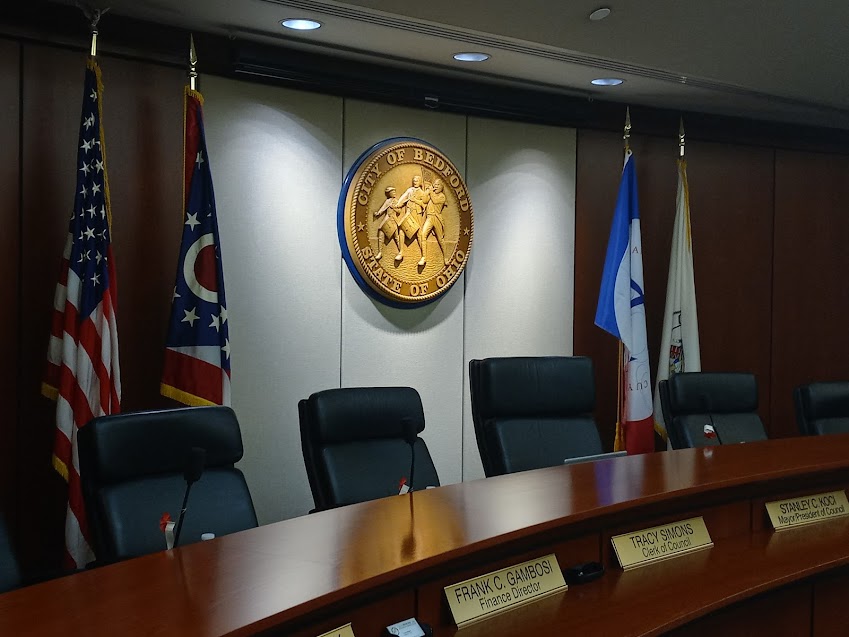Part of living in Bedford means that, one way or another, you will be dealing with the presence of deer. To some, the animals are a beautiful connection to nature and the nearby Metroparks. To others, the creatures are nuisances; four-legged eating machines that go to town on undergrowth and delay drivers as they criss-cross the city’s thoroughfares to find other places to munch.
As their numbers grow, the question rises as to what is the best way for a city to manage these creatures. In the past, Bedford has worked with the Ohio Department of Wildlife to gain permits in order to shoot or “cull” the deer population. Bedford City Manager Mike Mallis presented council with a request to do the same thing this winter during the meeting Monday evening.
The bigger the deer herd grows, the more risk there is of collisions with traffic. Mallis said the city is currently concerned with potential impacts on Rockside Road near the entrance to the old U.S. Bank property. Data shows that groups of deer have been known to frequent the area back there, as well in other places in the city including an area by Archer and Solon Roads.
Mallis said that in the past, the deer-culling program was used successfully to thin the number of deer that used to reside in the area by the wastewater treatment plant. That herd had similarly become a potential danger to drivers on Turney Road.
During the virtual meeting, Ward 6 Representative Don Saunders said that he has been concerned about the growing number of deer that now wander through the center of the city, including the many that frequently populate his own back yard. Ward 1 Representative Sandy Spinks said she also has noticed the large numbers of deer and added that she has seen quite a few females this year who had litters of three fawns as opposed to the more common one or two births per litter. She said she felt in the long run it was cruel to the animals let the population get too big.
According to a report by the Bedford City Police Department concerning a similar culling program in the winter of 2017-2018, officers were able to “remove” 20 deer from the population between the end of December through the middle of February. Nine males and eleven females were taken in the effort, along with the 19 unborn deer the females were carrying. The deer were lured in by corn, and all of the hunting was done by officers in the department. The carcasses that were removed were given to people who could use them for food.
Ward 2 Representative Wally Genutis has been an opponent of the culling procedure, and voiced his opinion to the board in a speech during the meeting, saying that he thought the city should move in a different direction.
“We are apparently killing them simply because people find them inconvenient when they jump in the street and what-not, or (when) they are eating our bushes,” he said.
Genutis said since there has recently been an influx of coyotes in the area, there is no need for culling the population to limit the numbers. He added that having better fencing options is the best way to protect plants, since a certain number of deer will inevitably remain due to the location of the city to the forests and water sources. (Council has been in talks recently about allowing residents to have higher than six-feet fences to keep the deer out of their yards.)
Genutis also asked if it is right to have the city’s safety forces killing the wildlife just to prevent the deer from potentially trotting out into a road and getting hit.
“We should honor the sanctity of life to live in harmony with our wildlife and all the plants and animals and (not) allow for the riches of these relationships to go untapped and squandered in a short-sighted, endless killing spree.”
The council made no decision concerning the program for this year at the meeting.
In other news, the board heard a proposal on a first reading from Mallis for the city to purchase a valve maintenance trailer for the Water Department from Bain Enterprises. He said he believed that this would be a vital piece to being able to exercise the valves on the water system throughout the city. Testing the valves, many of which are older, can pre-empt when one might break. Mallis said the city would be getting a good deal from the company, and that the machine would be a time-saver and a valuable part of the city’s asset management program.
The council also heard a proposal about purchasing two new smaller SUV-type vehicles for the fire department. Mallis said they would be able to get the vehicles at below the state bid price. The vehicles would be replacing two other vehicles that have around 130,000 miles on them, and are not as dependable for emergency work. Those older vehicles, in turn, would be moved to another department in the city to use.






